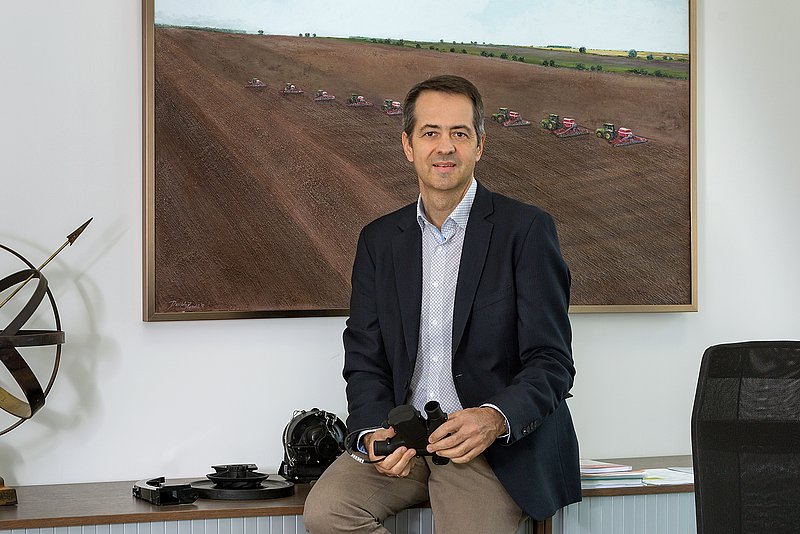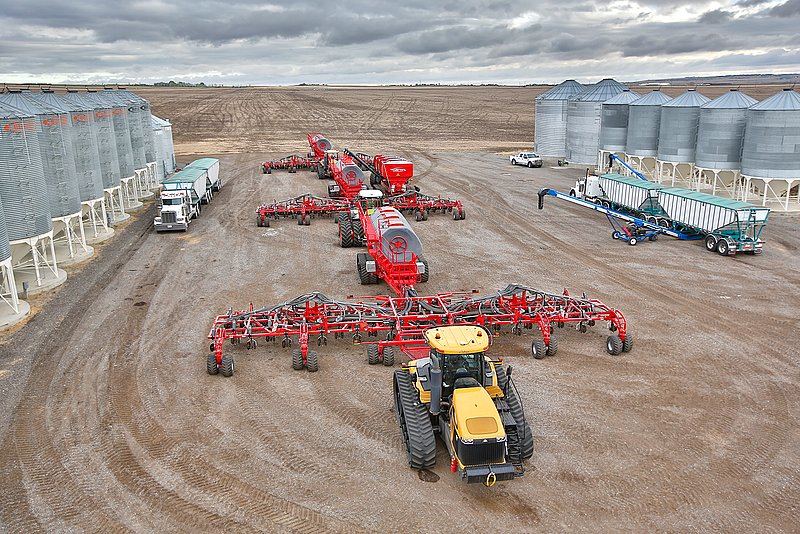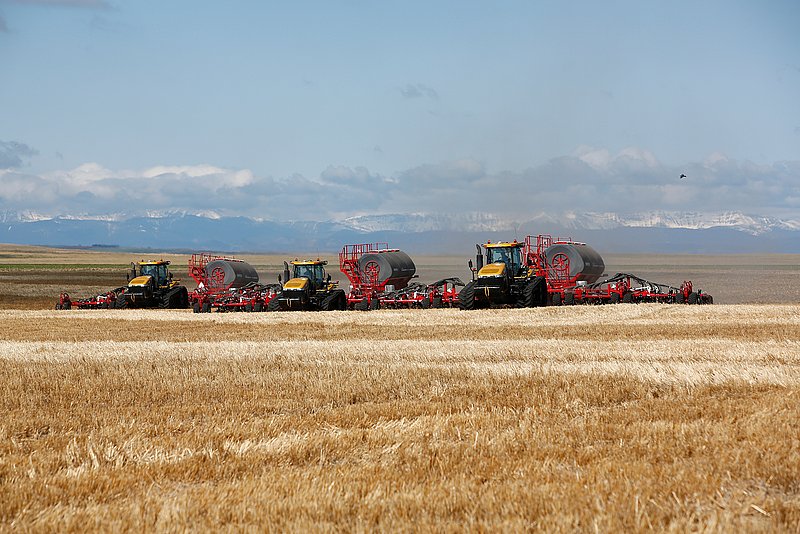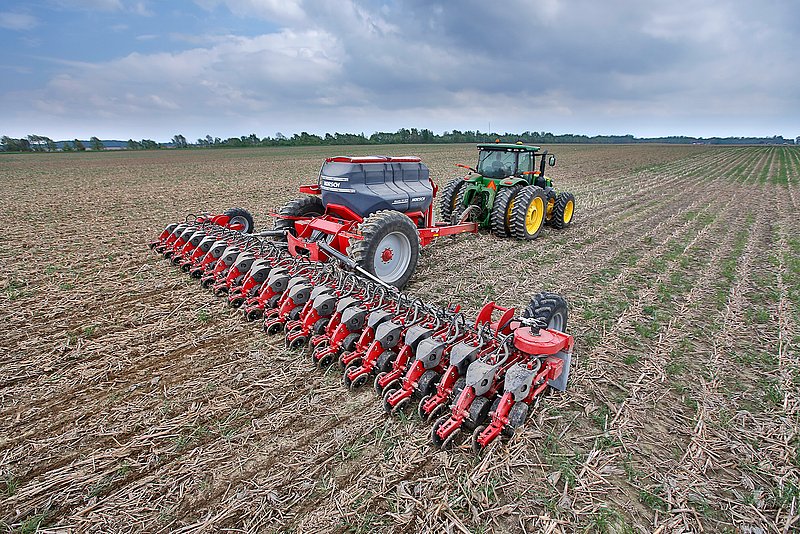HORSCH in North America
HORSCH has been operating on the North American market for quite some years. Philipp Horsch describes HORSCH’s history in North America and the objectives for the future.

terraHORSCH: Why did HORSCH decide to establish a subsidiary in the US?
Philipp Horsch: Our family has always had an affinity for North America. We have several family connections to the United States. Moreover, most members of our family spent a longer period of time in the States. Thus, it was not only a merely factual decision to establish a subsidiary in North America. Gut feeling, too, played a major role. Since the beginning of the 1990s we have been operating on the US American market. In the beginning, we closely co-operated with Case on the development of a special TerraTrac. Another example is at that time a new tine seed drill we developed with the company Concord for the European markets. The result of this co-operation was the well-known Airseeder that we sold in Europe very successfully. Our first HORSCH auger wagons 160 UW were completely manufactured in the US according to our specifications and then imported to Germany. As we already were regularly on site, we were tempted to become even more active on this market. At the end of the 1990s we, together with Kevin Anderson, launched a new Airseeder generation especially for the United States. And our business dealings gained momentum. It was only logical that we started to discuss having our own subsidiary in North America to be able to produce on site.

terraHORSCH: How would you describe the current situation of HORSCH in the US? What is the position of the company? Is it able to hold its ground?
Philipp Horsch: In 2011, we decided to build a factory in Fargo, North Dakota. In autumn 2013 all constructions were completed and we moved from South Dakota to Fargo in North Dakota. Unfortunately, it was exactly at this time that the whole US market broke down. The prices for soya and maize hit rock bottom and were almost cut in half. The market has not recovered until today and still is under great pressure. As a consequence the farmers‘ income decreased considerably and, thus, also the readiness for investments. The market for agricultural machinery dropped by 50 to 60 %. We were not prepared for this. After several years of growth in the US we were very euphoric and expected a lot from our new factory in Fargo. Since this time, however, the US market has been becoming more and more difficult. This year and next year, the market situation will not improve significantly. Spring in North America this year was marked by wet and cool weather. Maize and soya could only be sown very late. The result was that the harvest was postponed by four to eight weeks. Until recently, it still rained too much in the north of the US.
The farmers in North America and parts of Canada often had to cope with bad harvest conditions. A relatively early onset of winter additionally thwarted some farmers. The yields, as far as we can see at the moment, were rather average. However, you have to know that in spring approximately 10 % of the fields could not be sown at all even when it was possible to drive on them again, it was too late for sowing. In addition, the farmers struggle with low prices. All things considered the market in the US is under great pressure and business is only developing very slowly. And next year will be even more difficult than the past one!
terraHORSCH: What about the Canadian market? What are differences to the US?
Philipp Horsch: Since the 1990s Canada has been turning into a country where rape is the main crop. Due to the climate change and an improved variety breeding maize, soya and legumes slowly spread out in Canada, too. The farmers benefit substantially from that as these are not only crops that help to stabilise and improve their income, but they add to an improved rotation. Nevertheless, rape still plays the most important role in Canada. In the past years, compared to the US, the market in Canada has always been a little bit better as the Canadians did not depend to such an extent from maize and soya. However, last year, the Canadians also faced enormous problems in the rape sector because of the well-known trade turbulences with China.
At the moment, the US American as well as the Candian market have almost come to a standstill, as they are under enormous pressure. We are going to carry on and to continue to invest, for example last year in a branch for spare parts in Saskatoon (province Saskatchewan). Slowly but surely, we will get to where we want to be.

terraHORSCH: What are HORSCH’s strategies to develop the market in North America even better?
Philipp Horsch: Generally, we are focussing on establishing reasonable trade structures. We concentrate on the northern middle of the US, the so-called Corn Belt, and West Canada. It is not easy to set up sales areas and we more and more come to the conclusion that we have to increase our support from Germany. This year we have already taken some important steps in this respect. We sent some employees to Fargo that will support some departments on site. One employee is responsible for the introduction of SAP and the adaption of the design systems. One employee supports the service colleagues. At the beginning of next year, another employee will go to the US to, together with the sales colleagues, will establish further sales structures. These are important steps that show our commitment to the North American market. We invest a lot in this market – not only in infrastructure, sales and people. We also work intensely on transferring the HORSCH corporate culture to North America.
For the future, we see a lot of potential in the North American market. However, at the moment it still is very small and our turnover amounts to just under 30 million US Dollar. Before the crisis our turnover was higher. Now we are slowly recovering.
Last year we also invested in a farm in Downs, Illinois. We use it for field tests, machine demonstrations and trainings. This site will help us to further develop agronomic topics and to improve the communication with our customers and sales partners. That’s the key to develop the market in North America even better in the long run. Our objective always is to offer our customers an additional value.
terraHORSCH: What are your plans with regard to the technical aspects?
Philipp Horsch: In the US we are producing in imperial measurements to make sure that the products that are designed over there can also be produced there. We, of course, include all our know-how and complete the North American products with the appropriate European components.
In the long run, we are planning to pursue the harmonisation of our production sites all over the world in the R & D sector. Our objective is to create sort of a global platform. Especially for the US this means that in the future we will build machines according to the metric system. If we develop and produce machines with the same measuring units at each production site, we can flexibly react to changing market conditions. The ideal situation would be to use our factories all over the world at full potential as they are able to produce for the global market. This is one of our visions for the future.
In the long run we can imagine that with regard to the turnover potential the North American market might develop similar to the European market.
terraHORSCH: Why is it so difficult to gain a foothold on the North American market?
Philipp Horsch: The dealer landscape plays an important role. The dealers often sell machines of only one single brand. This trade structure is completely different from what we have in Europe. However, we slowly notice that something is changing in this respect. Farmers no longer want to be forced by the dealers to be limited to only one manufacturer of agricultural machinery. They want more variety to choose from.
Another reason is that it, of course, is a really large market. We do not concentrate on the whole land area, but to start with only on individual parts of the United States and Canada. It helps a lot that despite the size of both countries there is one common language – except for some parts in Canada – and that from a legal point of view jurisdiction is relatively homogeneous.
„When I was young I spent one year in the US to get to know the country and their way of farming.“
terraHORSCH: Are there other topics that influence the North American market?
Philipp Horsch: Like in Europe, environmental topics start playing a major role in the States. The largest lakes are located in the middle of the country, the Corn Belt. Increasing nutrient inputs in waters caused by the farming sector are discussed more and more intensely. At the same time, other sectors, for example the use of biogenetics in agriculture, are questioned, too. In North America farmers now also have to face societal topics and cannot simply ignore them. Not so very long ago it was not natural at all to deal openly with such topics.
Moreover, society more and more questions the farming methods in the Corn Belt, i.e. the tight rotation of maize and soya in turn and much more. Farmers more and more concentrate on the cultivation of catch crops and the basic extension of their rotation. Organic farming, too, becomes more and more important.

terraHORSCH: Are there topics where North American farmers are different from European farmers?
Philipp Horsch: There is one sector that North Americans are more susceptible to than Europeans: Prescription Farming. In North America farmers have more confidence in external consultants than in Europe. Cultivation consultants guide and direct farmers to a greater extent than in Europe. That’s also a question of mentality and culture.
Their attitude with regard to all topics around the use of digital media is very similar to ours.
Another topic where North American farmers are different from the European farmers is the working widths of their machines. The further you go north the shorter is the vegetation period. In spring, farmers often have a short window when the sowing conditions are optimum. This is why they want to get as much work as possible done in one pass. The machine widths in relation to the field sizes that have to be cultivated are larger than in Europe. In the north, farmers depend on large working widths. Further down south, that’s not the case, but the farmers still work with large working widths. And they are willing to invest quite a lot of money. In North America, a farm that cultivates 1000 ha of maize and soya at any rate disposes of an 18-m seed drill. For this farm size a farmer in Europe would maximally work with a 9 m seed drill. North Americans are more technophilic than we Europeans. Machines have to be large and passes have to be carried out fast. They are willing to invest much more money per hectare on technology.